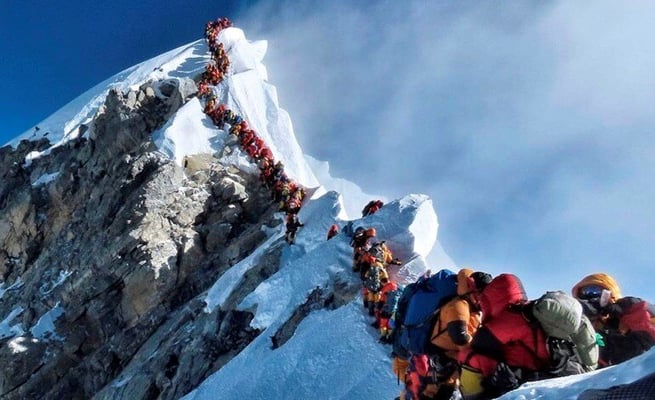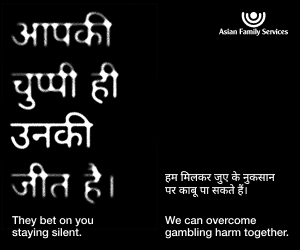Everest needs an urgent solution!

This week marked the sixty-sixth anniversary of the conquest of Mount Everest.
New Zealander Sir Edmund Hillary set foot on the 29,029-foot world’s highest mountain on 29 February 1953, which also happened to be his Nepali-Indian co-climber Sherpa Tenzing Norgay’s thirty-ninth birthday.
Unfortunately, however, this week also marked the eleventh death this year of an Everest climber.
Deaths on the mountain are not uncommon and there have been more than 300 known deaths in the past 56 years. But what has concerned the world is the sheer increase in the number of deaths in recent years.
The interval between the first Sir Edmund-Tenzing Norgay climb and the second by another set of climbers was at least a couple of years but now there are queues of literally dozens of climbers on most days of the climbing season.
Pictures of serpentine queues of climbers perching precariously on the razor sharp ridges leading up the peak, waiting for their individual moment of glory and the inevitably mandatory selfie, have gone viral this week.
The big concern a few decades ago was the litter that climbers left on the pristine slopes of the Himalayan range. Education and genuine concern have reduced pollution to a great extent, but the litter now seems to have been replaced by human bodies of the climbers themselves.
For the world’s media this month have been awash with reports of climbers of different nationalities who have perished either on the peak or on their way down, because of a slew of well known but potentially deadly challenges that climbers can face at great heights in the rarefied atmosphere.
There have also been callous-sounding stories of climbers having to step over bodies of dead mountaineers. But that may simply be the case because they might be trampling on the bodies as they scramble down the treacherous slopes in a tearing hurry trying to save their own lives.
With the mounting death toll making world headlines, the blame game has begun.
Nepal’s feeble economy depends greatly on the permits it sells internationally to those who want to climb the world’s highest peak. Estimates say the Everest permits and other spending by mountaineers pulls in US$300 million in revenue every year – a substantial contribution to its foreign exchange earnings.
Nepali authorities issued more than 380 permits this year alone. Experts say this is far too many for the sustainability of the Everest ecosystem. Authorities, however, dispute that the increased deaths are because of the perceived increased risk in the number of permits issued. They would rather blame it on the lack of training or poor preparedness of the climbers.
This year’s climbing season ends this month and the Nepali authorities need to draw up strategies on how to reduce deaths on the peak before the onset of the next season.
New Zealand has had a long deep and abiding relationship with Nepal and India ever since Sir Edmund’s great feat fifty-six years ago. That association is permanently commemorated by the name of the street on which the New Zealand High Commission in New Delhi’s diplomatic enclave is situated – Sir Edmund Hillary Marg.
The Sir Edmund Hillary Fellowship, most recently awarded to disabled Indian athlete Deepa Malik is another case in point.
Several institutions, many of them charitable, have been built around that relationship, particularly in Nepal targeted at economically challenged sections of Nepali society.
There couldn’t be a more timely opportunity for the three countries to come together to forge a plan to the save the world’s highest peak from both ecological degradation and the increasing numbers of climber deaths in future years.
This could be done by assisting Nepal find more sustainable alternatives to monetise this great and beautiful natural feature that it is blessed with rather than for its government to depend on revenue garnered from selling more and more climbing permits. The regime for granting permits would also need to be more stringent.
Such an initiative would be a fitting tribute to the memory of Sir Edmund and Sherpa Tenzing Norgay.
This week marked the sixty-sixth anniversary of the conquest of Mount Everest.
New Zealander Sir Edmund Hillary set foot on the 29,029-foot world’s highest mountain on 29 February 1953, which also happened to be his Nepali-Indian co-climber Sherpa Tenzing Norgay’s thirty-ninth birthday.
...
This week marked the sixty-sixth anniversary of the conquest of Mount Everest.
New Zealander Sir Edmund Hillary set foot on the 29,029-foot world’s highest mountain on 29 February 1953, which also happened to be his Nepali-Indian co-climber Sherpa Tenzing Norgay’s thirty-ninth birthday.
Unfortunately, however, this week also marked the eleventh death this year of an Everest climber.
Deaths on the mountain are not uncommon and there have been more than 300 known deaths in the past 56 years. But what has concerned the world is the sheer increase in the number of deaths in recent years.
The interval between the first Sir Edmund-Tenzing Norgay climb and the second by another set of climbers was at least a couple of years but now there are queues of literally dozens of climbers on most days of the climbing season.
Pictures of serpentine queues of climbers perching precariously on the razor sharp ridges leading up the peak, waiting for their individual moment of glory and the inevitably mandatory selfie, have gone viral this week.
The big concern a few decades ago was the litter that climbers left on the pristine slopes of the Himalayan range. Education and genuine concern have reduced pollution to a great extent, but the litter now seems to have been replaced by human bodies of the climbers themselves.
For the world’s media this month have been awash with reports of climbers of different nationalities who have perished either on the peak or on their way down, because of a slew of well known but potentially deadly challenges that climbers can face at great heights in the rarefied atmosphere.
There have also been callous-sounding stories of climbers having to step over bodies of dead mountaineers. But that may simply be the case because they might be trampling on the bodies as they scramble down the treacherous slopes in a tearing hurry trying to save their own lives.
With the mounting death toll making world headlines, the blame game has begun.
Nepal’s feeble economy depends greatly on the permits it sells internationally to those who want to climb the world’s highest peak. Estimates say the Everest permits and other spending by mountaineers pulls in US$300 million in revenue every year – a substantial contribution to its foreign exchange earnings.
Nepali authorities issued more than 380 permits this year alone. Experts say this is far too many for the sustainability of the Everest ecosystem. Authorities, however, dispute that the increased deaths are because of the perceived increased risk in the number of permits issued. They would rather blame it on the lack of training or poor preparedness of the climbers.
This year’s climbing season ends this month and the Nepali authorities need to draw up strategies on how to reduce deaths on the peak before the onset of the next season.
New Zealand has had a long deep and abiding relationship with Nepal and India ever since Sir Edmund’s great feat fifty-six years ago. That association is permanently commemorated by the name of the street on which the New Zealand High Commission in New Delhi’s diplomatic enclave is situated – Sir Edmund Hillary Marg.
The Sir Edmund Hillary Fellowship, most recently awarded to disabled Indian athlete Deepa Malik is another case in point.
Several institutions, many of them charitable, have been built around that relationship, particularly in Nepal targeted at economically challenged sections of Nepali society.
There couldn’t be a more timely opportunity for the three countries to come together to forge a plan to the save the world’s highest peak from both ecological degradation and the increasing numbers of climber deaths in future years.
This could be done by assisting Nepal find more sustainable alternatives to monetise this great and beautiful natural feature that it is blessed with rather than for its government to depend on revenue garnered from selling more and more climbing permits. The regime for granting permits would also need to be more stringent.
Such an initiative would be a fitting tribute to the memory of Sir Edmund and Sherpa Tenzing Norgay.









Leave a Comment